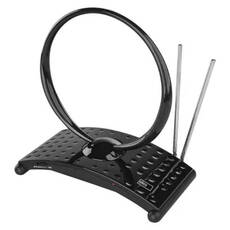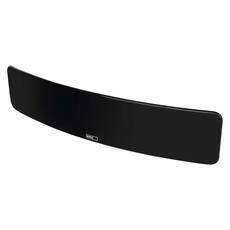Indoor TV Antenna
An indoor antenna is a device used in the home to receive a television signal. If you live in an area or city where signal strength is excellent, an indoor TV antenna is sufficient and you do not need an outdoor antenna. Why? Because in this case, an indoor antenna can give us the perfect signal strength, i.e. a crystal clear picture and good sound. Because distance from the TV tower or very favourable terrain conditions are crucial to avoid having to buy a much more expensive outdoor antenna than an indoor antenna. Read more...
• For indoor usage, active TV antenna
• Modern SMD circuit technology
• With 5G<E filter (It filters out 5G and LTE frequencies that can interfere with over-the-air TV reception if you live near a cell tower)
• VHF 174-230 MHz
• UHF 470-697 MHz
• Shielded for minimum interference
• Built-in high-gain and low-noise amplifier
• Ideal tube design, extremely space saving
• Powered by DTV, set-top-box through coaxial cable or separate power adapter
• For indoor/outdoor use
• LTE/4G/5G filter
• Reception: DVB-T/T2
• Frequency bands: UHF
• Frequency range: 470-698 MHz
• Vertical and horizontal polarization
• Reception angle: 30°/40°.
• Capable of receiving Full HD broadcasts and multiple transmitters
• Coaxial cable length: 5 m
• Connector type: F, IEC
• Power supply: DC USB 5 V/550 mA (included)
• External low noise amplifier with separate source
• Output RF impedance: 75 Ohm
• Recommended installation distance from TV tower: 0-80 km (village)
• Dimensions: 315 × 215 × 200 mm
• Version: Indoor
• Filters: LTE, 5G
• Frequency range: 87,5-230 MHz, 470-6980 MHz
• Output RF impedance: 75 Ohm
• Frequency bands: FM/VHF/DAB/UHF
• Suitable for receiving Full HD broadcasts: Yes
• For indoor and outdoor use, passive TV antenna
• VHF 174-230 MHz
• UHF 470-862 MHz
• Can also receive digital radio broadcasts (DAB)
• Shielded coaxial cable and coaxial plug for interference-free reception
• Ideal for recreational activities such as caravanning or boat use
• Omnidirectional, so no (horizontal/vertical) adjustment is required with transmitters of different polarities
• Cable length: 2m
• Antenna height: 17 cm
• For indoor and outdoor use, passive TV antenna
• VHF 174-230 MHz
• UHF 470-862 MHz
• Can also receive digital radio broadcasts (DAB)
• Shielded coaxial cable and coaxial plug for interference-free reception
• Ideal for recreational activities such as caravanning or boat use
• Omnidirectional, so no (horizontal/vertical) adjustment is required with transmitters of different polarities
• Cable length: 1,5 m
• Antenna height: 35 cm
Special gross price: 4.80€ (Net price: 3.78€)
• Version: Indoor
• Filters: LTE/4G/5G
• Frequency range: 87,5-230 MHz, 470-790 MHz
• Output RF impedance: 75 Ohm
• Frequency bands: FM/VHF/DAB/UHF
• Suitable for receiving Full HD broadcasts: Yes
• Use: Indoor
• Indoor use. indoor. filters:LTE, 4G, 5G
• Frequency range: 47-230 MHz, 470-698 MHz
• Range: 0-25 Km
• RF output impedance: 75 Ohm
• Reception: FM/DAB/DVB-T/T2
• Frequency bands: FM/VHF/DAB/UHF
• Full HD reception: Yes
• Built-in low noise amplifier with separate power supply
• Version: Indoor
• Filters: LTE/4G/5G
• Frequency range: 87,5-230 MHz, 470-790 MHz
• Output RF impedance: 75 Ohm
• Frequency bands: FM/VHF/DAB/UHF
• Suitable for receiving Full HD broadcasts: Yes
• Use: Indoor
• LTE filter: yes
• LTE LTE Outdoor use
• Dimensions: 1.3 × 228 x 128 mm
• Range: 0-25 Km
• DVB-T2, DAB, LTE/4G/5G filter
• Amplifier: stepped, low-noise amplifier with separate power supply
• Connector type: IEC
What to look for when choosing indoor antennas?
Signal strength is probably the most important factor for these antennas, because if it is not adequate, you will need an outdoor antenna, not an indoor one. However, before you go to the expense, you should check that if the reception is strong enough, you can use a coaxial cable with shielding or an antenna amplifier that boosts DVB-T2 reception. But it can be argued that in large cities, an indoor DVB-T or DVB-T2 antenna is sufficient. In addition, most of the modern indoor antennas available today can also receive full-HD broadcasts.
Well, if you want to enjoy TV in this quality, you need to make sure that the antenna you choose is suitable. The second most important is the picture and sound quality, which depends on the strength of the signal. If it fluctuates, which you can't help, you may experience a slight change in picture and sound, and in more problematic cases the picture may freeze and you may have to restart the TV.
There are times when the purchase of an antenna amplifier will resolve the situation and you don't need to purchase an outdoor antenna. Thirdly, you need to pay attention to the length of the cable. Ennek hossza attól függ, hogy mekkora helyiségben kell elhelyeznünk a televíziót és a DVB-T vagy DVB-T2-es antennát, mert a túl hosszú kábel gyengítheti a jelet.
What are the advantages of installing an indoor antenna?
There are two major advantages to using indoor antennas. One is the ease of installation and the other is the low purchase price and the fact that there is no monthly cost. If you choose to contract with a cable or satellite provider, you will have to pay a monthly fee in order to watch the channels. This is not the case with indoor aerials. Az igaz, hogy valószínűsíthetően ekkor több csatornát tudunk nézni, de valóban érdekelnek is bennünket azok a műsorok, vagy csak büszkeséggel tölt el bennünket, hogy például 99 csatorna közül választhatunk?
Well, the annual subscription to a cable provider is more expensive than buying an indoor antenna. Because DND Telecom's webshop offers a wide range of indoor antennas, if you are not sure which one is right for you, contact the webshop's customer service team for help.
What brands of indoor antennas are available in the DND Telecom webshop?
The DND Telecom webshop offers a selection of indoor antennas from Goobay, EMOS and Amiko. Some models of EMOS brand indoor TV antennas are suitable for receiving both analogue FM radio and digital DAB radio frequencies. Therefore, in the indoor antenna category of the DND Telecom webshop, you will find indoor antennas with DVB-T capability and an active amplifier. These indoor antennas are also suitable for reception of the All TV and All TV Premium (formerly known as MinDig TV Extra) services. These are digital TV channels broadcast terrestrially and received on DVB-T and DVB-T2 platforms.
How to set up your indoor TV aerial correctly?
The first step is to unplug your TV set and then connect your indoor aerial to your TV with a coax cable. If you have a digital TV, connect the cable directly. If you have an analogue TV, use a set-top box. Then plug both the indoor aerial and the TV into the network, then switch on the TV and program the channels.









